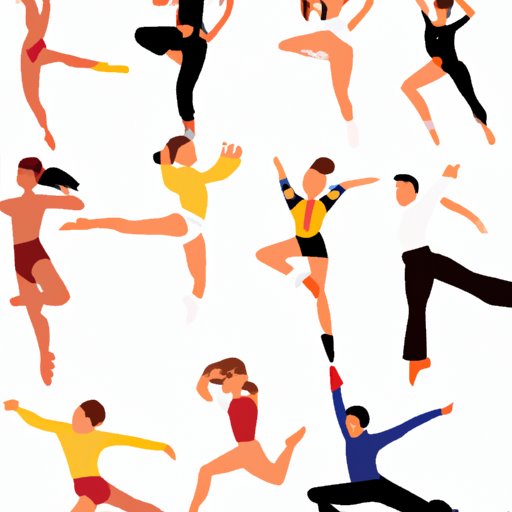Introduction
Dancing is often associated with entertainment and artistic expression, but it is also a physical activity that requires athleticism, focus, and coordination. From ballet to hip hop, various styles of dance have been around for centuries, and today it is considered a competitive sport. This article will explore the physical, mental, and competitive aspects of dance to demonstrate why it should be considered a sport.
Physical Benefits of Dancing
The physical benefits of dancing are vast. It is an aerobic activity that helps to improve cardiovascular health, increase flexibility, and strengthen muscles. According to a study conducted by the American Council on Exercise, “dancing has the potential to improve muscular strength, endurance, and power.” Furthermore, dancing requires agility, strength, and endurance, which are all important components of physical fitness.
In addition, dancing requires balance and coordination. It engages multiple muscle groups at once, which can help improve posture, balance, and stability. In fact, a study published in the Journal of Sports Science & Medicine found that “dancing was associated with improved balance, even when compared with other forms of physical activity.” This suggests that dancing is a great way to improve overall physical fitness.
Mental Benefits of Dancing
In addition to the physical benefits of dancing, there are also mental benefits. Dancing can improve focus, coordination, and memory. It is a complex activity that requires concentration and attention to detail. Memorizing choreography and executing movements in time with the music can be mentally challenging, yet rewarding.
Furthermore, dancing can be a great way to relieve stress and boost self-confidence. A study published in the journal Frontiers in Psychology found that “dancing can reduce anxiety and depression, while increasing positive emotions and self-esteem.” Thus, dancing can be a great outlet for those looking to improve their mental health.
Comparison to Other Sports and Activities
When compared to other sports and activities, such as gymnastics or running, dancing stands out due to its unique skills and techniques. Gymnastics requires strength and flexibility, while running requires endurance. However, dancing requires all of these components, as well as balance and coordination. Furthermore, unlike many other sports, dancing is an art form that allows for creative expression and interpretation.
In addition, dancing requires a greater level of control and precision than many other physical activities. The movements must be executed with accuracy and finesse, which can be difficult and challenging. This makes dancing a unique and demanding activity that requires skill, dedication, and practice.
Competitive Aspects of Dance
Dancing is also a competitive sport. Professional dancers compete in various competitions and showcases, and awards are given to those who demonstrate exceptional skill and technique. There are numerous dance competitions around the world, including the World Dance Championships and the International Dance Organization World Cup. These competitions showcase the best dancers from around the world and provide an opportunity for them to display their talents on a grand stage.
Furthermore, there are many professional dance companies and troupes, such as the Royal Ballet and the New York City Ballet. These organizations employ some of the best dancers in the world and provide an opportunity for them to hone their skills and perform on a professional level. Thus, the competitive aspect of dance is just as important as the physical and mental benefits.

History of Dance as a Sport
Dance has a long history as a sport, dating back to ancient times. In ancient Greece, dancing was seen as a way to honor the gods and celebrate special occasions. In the Middle Ages, dance was used as a form of entertainment and social interaction, and in the Renaissance period, it was used as a way to show off one’s skill and grace. Today, dance is still seen as an art form, but it is also a competitive sport that requires athleticism, focus, and coordination.
Throughout history, dance has been used to express emotion, tell stories, and bring people together. It has been an important part of many cultures and societies, and it has evolved over time. Today, dance is still seen as a form of entertainment, but it is also seen as a competitive sport that requires athleticism and skill.
Various Styles of Dance
There are many different styles of dance, each with its own set of skills and techniques. Ballet is a classical style of dance that focuses on grace and poise, while hip hop is a more modern style that emphasizes rhythm and energy. Tap dancing is a rhythmic style that requires footwork and coordination, while ballroom dancing is a social style that focuses on partner connection and communication.
Each style of dance requires different skills and techniques. For example, ballet requires flexibility and control, while hip hop requires sharp movements and precise timing. Furthermore, each style of dance has its own unique history and cultural significance. Thus, it is important to recognize the various styles of dance and the different skills needed to master them.
Conclusion
From its physical, mental, and competitive aspects, it is clear why dancing should be considered a sport. It is an activity that requires athleticism, focus, and coordination. It can improve physical fitness, mental health, and self-confidence. Moreover, it has a long history as a competitive sport and is full of various styles and techniques. Thus, it is evident that dancing is a sport that deserves recognition and respect.
(Note: Is this article not meeting your expectations? Do you have knowledge or insights to share? Unlock new opportunities and expand your reach by joining our authors team. Click Registration to join us and share your expertise with our readers.)
